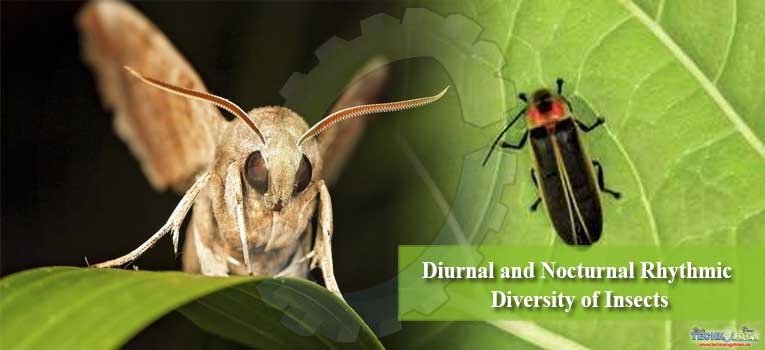Diversity is generally referred to the characteristic of variety of species. It is richness of the number of species per unit area. Insects are among the most diverse group of animals on the planet.
 Class Insecta consists of invertebrates within the phylum Arthropoda having three body parts, a chitinous exoskeleton, three pairs of jointed legs, compound eyes and one pair of antennae. Many orders of insects are recognized today.
Class Insecta consists of invertebrates within the phylum Arthropoda having three body parts, a chitinous exoskeleton, three pairs of jointed legs, compound eyes and one pair of antennae. Many orders of insects are recognized today.
For example, the Blattodea, Coleoptera, Dermaptera, Diptera, Hemiptera, Hymenoptera, Isoptera, Lepidoptera, Mantodea, Neuroptera, Odonata, Orthoptera, Phasmatodea, Phthiraptera, Psocoptera, Thysanoptera and Zoraptera.
Hemiptera and Diptera are the most important insect orders. Insects are unique in their own way and have an important ecological role for survival of life on Earth.
Insects have six legs for walking and adopted a tripedal gait. The tripedal gait allows for rapid walking while always having a stable stance and has been studied extensively in cockroaches.
They live together in large well-organized colonies that may be so tightly integrated and genetically similar that the colonies of some species are sometimes considered super organisms.
It is sometimes argued that the various species of honey bee are the only invertebrates (and indeed one of the few non-human groups) to have evolved a system of abstract symbolic communication where a behavior is used to represent and convey specific information about something in the environment.
In this communication system, called dance language, the angle at which a bee dances represents a direction relative to the sun, and the length of the dance represents the distance to be flown.
They are found in nearly all environments, although only a small number of species reside in the oceans, a habitat dominated by another arthropod group crustaceans (Erwin and Terry, 1982).
A large number of insects live either parts or the whole of their lives underwater. In many of the more primitive orders of insect, the immature stages are spent in an aquatic environment. Some groups of insects, like certain water beetles, have aquatic adults.
Insects shows two types of metamorphosis complete and incomplete metamorphosis. Holometabolism (complete metamorphosis) is where the insect changes occur in four stages, an egg or embryo, a larva, a pupa and the adult or imago. In these species, egg hatches to produce a larva, which is generally worm-like in form.
The larva grows and eventually becomes a pupa, a stage marked by reduced movement and often sealed within a cocoon. The pupae may be obtect, exarate or coarctate.
Obtect pupae are compact, with the legs and other appendages enclosed. Exarate pupae have their legs and other appendages free and extended e Corestate pupae develop inside the larval skin.
In insects which show hemi-metabolism, changes occur gradually by undergoing a series of molts. An insect molts when it outgrows its exoskeleton, which does not stretch and would otherwise restrict the insect’s growth.
The molting process begins as the insect’s epidermis secretes a new epicuticle. When this stage is complete, the insect makes its body swell by taking in a large quantity of water or air, which makes the old cuticle split along predefined weaknesses where the old exo-cuticle was thinnest.
Diurnal rhythum is a plant and animal behavior characterized by activity during the day, with a period of sleeping or other inactivity at night. Different behaviors may occur at different times of year.
Diurnality is a cycle of activity with a twenty-four-hour period while other cyclic activities are described as circadian rhythms. Animals that are not diurnal might be nocturnal (active at night) or crepuscular.
On the other hand, nocturnal rhythum is an animal behavior characterized by activity during the night and sleeping during the day.
Nocturnal creatures generally have highly developed senses of hearing, smell, and specially adapted eyesight. Such traits are helpful for animals such as the Helicoverpa zea moths to avoid predators.
Many insects are valuable to human such as bees having an important role in the process of pollination of agricultural crops. Furthermore, some of the insects also provide us honey, silk and other commercial value products and serve as food for bird, fish and beneficial animals.
They perform valuable services such as scavenger and useful participation in medicine and scientific research. Some insects are harmful and some of them transmit diseases to human and other animals like malaria transmitted by mosquitoes.
Insect pests inflict their damage on stored products mainly by direct feeding. Some species feed on the endosperm causing loss of weight and quality, while other species feed on the germ, resulting in poor seed germination and less viability.
Hemiptera and Diptera are the most important insect orders. Thus, due to damage done by these, grains lose their value for marketing and consumption or planting.
Authors: Sehar Shah, Dr. Rao Zahid Abbas, Dr. Muhammad Salman